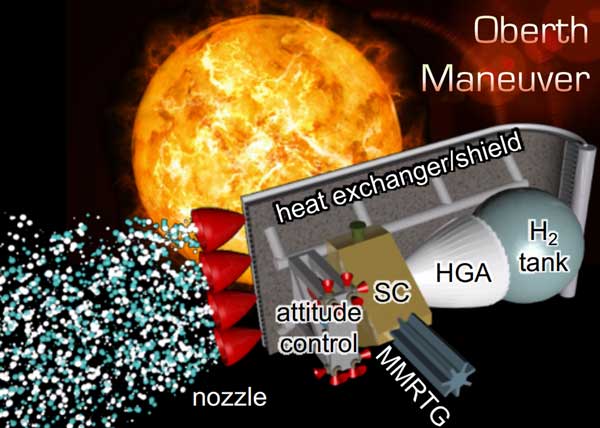
NASA Funds Research into Using the Solar Oberth Maneuver to Explore Deep Space (Image Credit: Payload)

by Douglas Messier
Managing Editor
NASA is funding research into advanced technology that would allow spacecraft to combine its propulsion system and the sun’s gravity to reach the distant Kuiper Belt or interstellar space in far less time than is possible today.
The space agency awarded a NASA Innovative Advance Concepts (NIAC) Phase I award worth $175,000 to Jason Benkoski of Johns Hopkins University to conduct research into how to successfully conduct a powered flyby of the sun known as the Oberth maneuver.
“We are proposing a combined heat shield and solar thermal propulsion system to perform a solar Oberth maneuver in order to achieve the highest possible escape velocity from the solar system for missions to Kuiper Belt Objects or interstellar space. Our team has designed and built working solar thermal propulsion prototypes out of materials that can survive 2800 K at a 20 x 20 cm scale. These benchtop-scale demonstrations have thus far validated our thermal and propulsion models,” Benkoski said in the project abstract.
Wikipedia describes the Oberth maneuver as a powered flyby “in which a spacecraft falls into a gravitational well and then uses its engines to further accelerate as it is falling, thereby achieving additional speed. The resulting maneuver is a more efficient way to gain kinetic energy than applying the same impulse outside of a gravitational well. The gain in efficiency is explained by the Oberth effect, wherein the use of a reaction engine at higher speeds generates a greater change in mechanical energy than its use at lower speeds.”
The maneuver is named after engineer Hermann Oberth, who first described it in his book, Wege zur Raumschiffahrt (Paths to Spaceflight), published in 1929.
Benkoski said the NIAC funding will go to studying propellants that spacecraft performing the Oberth maneuver would use.
“Despite growing confidence that a full-scale heat shield/heat exchanger can survive an Oberth maneuver, many questions remain regarding the feasibility of long-term cryogenic storage. We therefore propose a full trade study of alternate propellants in order to determine the maximum escape velocity for a given total system mass, including spacecraft, heat shield, propellant storage, and attitude control system. The main propellants of interest include H2, LiH, Li, CH4, NH3, and H2O,” he wrote in the abstract.
“Approximately 130 known dwarf planets inhabit the trans-Neptunian region. Dwarf planets are the most common type of planet in the solar system, far outnumbering giant planets and terrestrial planets. They are also the least explored. Ceres, Pluto, Charon, and Triton (the latter two often considered as both satellites and dwarf planets) remain the only explored dwarf planets,” the document said.
The project abstract follows.
Combined Heat Shield and Solar Thermal Propulsion System for an Oberth Maneuver
Jason Benkoski
Johns Hopkins University
NIAC Phase I
Amount: $175,000
Length: 9 months
Central Objective: We are proposing a combined heat shield and solar thermal propulsion system to perform a solar Oberth maneuver in order to achieve the highest possible escape velocity from the solar system for missions to Kuiper Belt Objects or interstellar space. Our team has designed and built working solar thermal propulsion prototypes out of materials that can survive 2800 K at a 20 x 20 cm scale. These benchtop-scale demonstrations have thus far validated our thermal and propulsion models.
Despite growing confidence that a full-scale heat shield/heat exchanger can survive an Oberth maneuver, many questions remain regarding the feasibility of long-term cryogenic storage. We therefore propose a full trade study of alternate propellants in order to determine the maximum escape velocity for a given total system mass, including spacecraft, heat shield, propellant storage, and attitude control system. The main propellants of interest include H2, LiH, Li, CH4, NH3, and H2O.
Methods: First we would determine material compatibility for each propellant with respect to its proposed storage system. We then calculate the efficiency (specific impulse) as a function of temperature for each propellant using Chemical Equilibrium Analysis (CEA). Using information from published studies of propellant storage systems, we would determine how the mass and volume of the tank scale with the quantity of propellant for realistic tank designs.
Next, we devise an equation for the area of the heat shield as a function of propellant quantity. Finally, the above inputs would be used to perform a full system mass trade to determine the maximum propellant fraction that can be achieved within the payload limitations of an SLS transit to Jupiter
Significance: Approximately 130 known dwarf planets inhabit the trans-Neptunian region. Dwarf planets are the most common type of planet in the solar system, far outnumbering giant planets and terrestrial planets. They are also the least explored. Ceres, Pluto, Charon, and Triton (the latter two often considered as both satellites and dwarf planets) remain the only explored dwarf planets.
Also little explored is the local interstellar medium. Although the Voyager 1 and 2 probes have exited the heliosheath, neither were designed for heliophysics observations. The Pioneer 10 and 11 probes, while in interstellar space, have long ceased functioning; New Horizons is expected to meet a similar fate.
The feasibility of deep space exploration hinges on a high solar system escape velocity (> 10 astronomical units per year), as the potentially long transit times pose extreme challenges for both hardware reliability and staffing. The development of efficient propulsion systems with high thrust can thus generate significant cost savings and risk reduction.
Consider a mission to the near interstellar medium (~550 AU). Voyager 1–the current record-holder at 3.6 AU/yr–will not journey this far for another 100 years. An SLS rocket with a Jupiter gravity assist offers improvement, but it tops out at 8 AU/yr for a ~1 tonne spacecraft payload. Crucially, the fly-out direction depends on Jupiter’s orbital position, which greatly limits the possible scientific objectives. A solar Oberth maneuver offers much more freedom for the fly-out direction.








